Related Research Articles

The Brown Swiss or American Brown Swiss is an American breed of dairy cattle. It derives from the traditional triple-purpose Braunvieh of the Alpine region of Europe, but has diverged substantially from it. It was selectively bred for dairy qualities only, and its draft and beef capabilities were lost. Milk yield was measured in 2013 at 10231 kg (22600 lb) per year; the milk has about 4% butterfat and 3.5% protein and is suitable for making cheese.

Mayrhofen is a town in the Zillertal in the Austrian state of Tyrol. It is located approximately an hour from the Tyrolean capital city of Innsbruck.

The Braunvieh or Swiss Brown is a breed or group of breeds of domestic cattle originating in Switzerland and distributed throughout the Alpine region. It falls within the "Brown Mountain" group of cattle breeds. The Swiss Braunvieh was originally a triple-purpose animal, used for milk production, for meat and for draught work; the modern Braunvieh is predominantly a dairy breed.

The Tux-Zillertal, German: Tux-Zillertaler, is an endangered Austrian breed of domestic cattle. It was created in 1982 when two similar Alpine breeds, the Tux and the Zillertal, were merged. The two names derive from those of the municipality of Tux in the Tuxertal, and of the neighbouring Zillertal, both in the Tirol region of Austria. The Tux-Zillertal may derive from the Swiss Hérens breed. Like the Hérens, it was long selected for the fighting ability of the cows, at the expense of productive characteristics.
The Original Braunvieh is a dual purpose dairy and beef breed from the Switzerland. Braunvieh means "brown cow" and the animals are coloured grey to brown with white ears and muzzle and have horns. These cattle have been maintained as a pure breed, while the modern Swiss Braunvieh have been crossed with Brown Swiss. They have contributed to the American Brown Swiss breed. In the 1980s breeding associations were formed in Germany and Austria to conserve the breed.

The Styrian Coarse-haired Hound is a breed of medium-sized hound dog originated in the Austrian province of Styria. It is bred as a scenthound, for hunting boar in mountainous terrain. The breed is one of the large Austrian Bracke.

The Zugspitzebahn was the first wire ropeway to open the summit of the Zugspitze, Germany's highest mountain on the border of Austria. Designed and built by Adolf Bleichert & Co. of Leipzig, Germany, the system was a record-holder for highest altitude. Opening in 1926, the Zugspitzebahn connected the Austrian town of Ehrwald with the top station at 2,950 metres above sea level next to the summit of Zugspitze.

The Braunes Bergschaf is a breed of domestic sheep from the Tyrol area of Austria and Italy. It derives from cross-breeding of the Tiroler Steinschaf of the Tyrol with the Italian Bergamasca and Padovana breeds. It is raised in the Austrian states of Lower Austria, Salzburg, Styria and Tyrol; in the Vinschgau, Ultental, Passeiertal and Schnalstal in the autonomous province of Bolzano in Italy; in the Swiss Engadine; and in Baden-Württemberg, Bavaria, Lower Saxony and Mecklenburg-Vorpommern in Germany.
The Feldalphorn, also known as the Feldalpenhorn, is a 1,923 m (AA) high mountain in the Kitzbühel Alps in Tyrol, Austria.
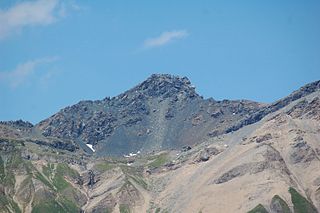
The Lizumer Reckner is, at 2,886 m above sea level (AA), the highest mountain in the Tux Alps in the Austrian state of Tyrol.
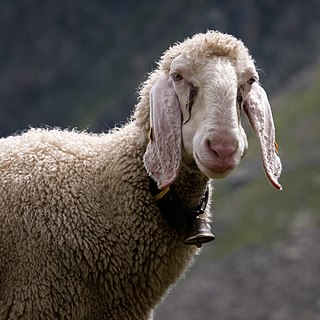
The Tiroler Bergschaf or Pecora Alpina Tirolese is a breed of domestic sheep from the mountainous Tyrol area of Austria and Italy. The name means "Tyrolean mountain sheep". It is raised throughout Austria and in the autonomous province of Bolzano in Italy. It results from cross-breeding between the Tiroler Steinschaf of the Tyrol with the Italian Bergamasca breed from the area of Bergamo. This is variously reported as having taken place in the first half of the 19th century and after the Second World War.
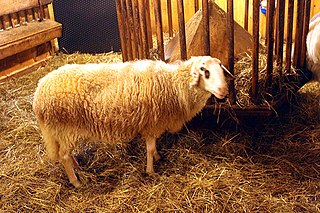
The Tiroler Steinschaf or Pecora della Roccia Tirolese is a breed of domestic sheep from the mountainous Tyrol area of Austria; a few are raised in Italy. The name means "Tyrolean rock sheep". It is raised in the states of Tyrol and Salzburg in Austria and in the autonomous province of Bolzano in Italy. It dates from the early 19th century and is the oldest Tyrolean sheep breed.

Rupert Huter was an Austrian clergyman and botanist.

The Museum der Völker in the Austrian Schwaz in the county of Tyrol was founded in 1995 as a cultural association Haus der Völker by Gert Chesi and belongs to the well known Ethnology museums in Europe. After a new construction and remodeling the exhibition operation opened on the 12th of April 2013 as Museum der Völker. Translated the name means museum of the peoples or museum of the tribes.

The Bruna dels Pirineus, Spanish: 'Bruna de los Pirineos', is a breed of cattle from the south-eastern Pyrenees, in the northern part of Catalonia. It derives from cross-breeding of local cattle with Swiss Braunvieh stock imported in the nineteenth century through France and through the Val d'Aran. It is distributed throughout the northern comarcas of Catalonia, Alta Ribagorça, Alt Urgell, Berguedà, Cerdanya, Pallars Jussà, Pallars Sobirà, Ripollès, Solsonès and Val d'Aran. The Bruna dels Pirineus constitutes about 80% of the beef herd of Catalonia.
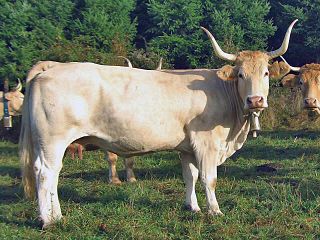
The Pirenaica, Basque: Behi-gorri, is a breed of beef cattle indigenous to the Pyrenees of north-eastern Spain. It is distributed mainly in the autonomous communities of Navarre and the Basque Country, but is present in much of the northern part of the country. It is well adapted to the mountainous terrain and humid climate of the area. It came close to extinction in twentieth century, but is not now at risk.

The Rätisches Grauvieh is an endangered Swiss breed of cattle from the Graubünden in eastern Switzerland. It is a smaller type of the Tiroler Grauvieh breed of Alpine grey cattle. In the 1920s it was absorbed into the Braunvieh population. In 1985 the population was re-established by the introduction of cattle of the similar Albula type from Austria. Like the Rhaetian Alps, it is named for the Ancient Roman province of Rhaetia.
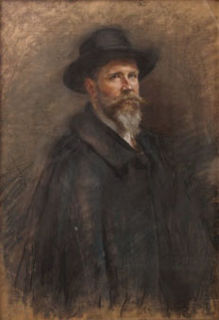
Josef Schretter was an Austrian painter; specializing in portraits and genre scenes.
References
- ↑ Breeds reported by Austria Domestic Animal Diversity Information System of the Food and Agriculture Organization of the United Nations. Accessed November 2016.